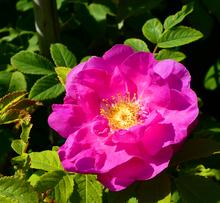Summer is gone - well, not really, but we are edging towards fall. I have picked blueberries, cloudberries, nordic brambles (very rare, but the tastiest berries you'll ever come across!) and raspberries and harvested my garlic. The green house produces cucumbers, tomatoes, chili peppers and other niceties. The garden is abounding with colors. There were about 150 visitors in the garden for the Open Garden event. The visitors could see flowering trees and perennials and a few rose bushes in full bloom. They could also admire a lot of rose buds just starting to show some color! The visitors seemed happy enough, though. One young lady said: " I need to pinch my arm every now and then to make sure this is not just a dream!" Lately there have been people walking around in the garden and, when leaving, thanking for received "color therapy".
The new seedlings have started to produce flowers (see pictures). Repeat flowering roses normally produce their first flower about two months after germination. If you produce a rose that flowers only once a summer, you have to wait for at least 5 years before you get to see the first bloom. Some of this year's newcomers I will certainly continue to grow for a few more years to see if they will get a permanent place in the garden.
I have also taken some hundred summer cuttings from various roses. Roses grown on their own roots normally gain an extra hardiness zone. The soil mixture I use is very easy to mix: one third normal soil, one third unfertilized peat (I make the peat myself from oak leaves) and one third sand. In the bottom of the pot I put some good soil mixed with bone meal. On top of that I add another inch of my own mix for cuttings. Then I place all the cuttings I have from the same rose along the edges of the pot and fill it with the cutting mixture, raise the cuttings into an upright position and press the soil around the cuttings. That way I know the cutting does not end up in the good soil. Then I just water the pot thoroughly and make sure it keeps moist. The good soil with bone meal in the bottom is to make sure the cuttings get some food soon after they have started to produce roots. That way they have time to strengthen their root system before being re-potted.





